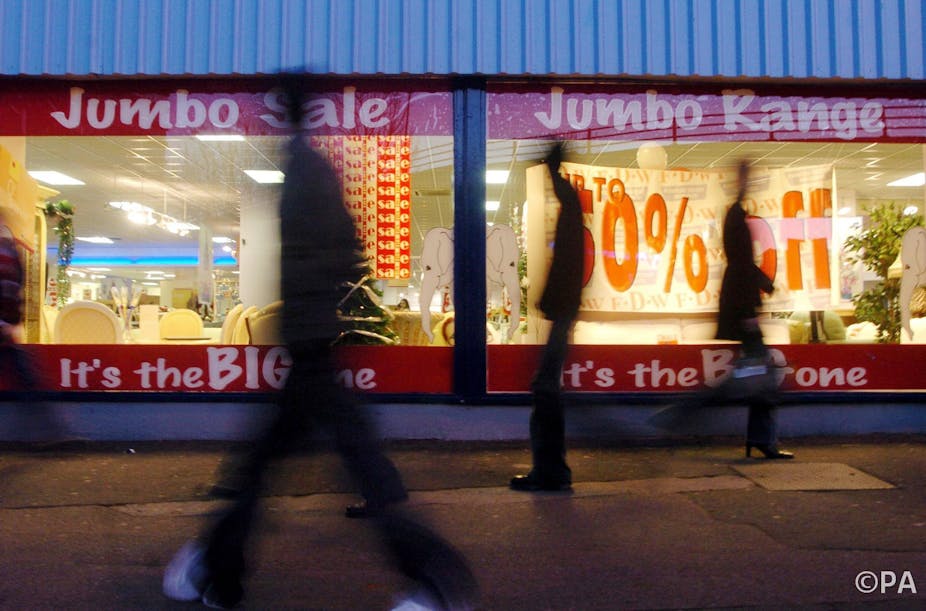The discount label is a familiar sight in UK shops. Everything from expensive televisions to supermarket essentials now seem to be offered for less than their original prices. But how often is the discount genuine?
The issue has been in the news recently with reports of retailers offering apparently fake bargains to their consumers. Tesco has been fined £300,000 in Birmingham for selling strawberries at “half price” for several months even though the full price of £3.99 was in place for just one week. The Office of Fair Trading (OFT) is currently investigating a number of furniture and carpet retailers for making price claims of the “was £600, now £300” variety, although allegedly few units were sold at the original price.
Similar stories appear regularly in the media, including allegations that duty-free shopping can be more expensive than high-street shopping, that some bargains advertised on daily deal websites (such as Groupon) are no bargain at all, that “buy-one, get-one-free” deals merely involve re-packaging into smaller containers, or that a supermarket’s heavily advertised 15% price cut was preceded by an (unadvertised) gradual 20% price rise.
These marketing tactics aren’t new. There is a story of two tailors in 1930s Brooklyn, the Drubeck brothers Sid and Harry. When a customer had found a nice suit and asked Sid its price, Sid would shout to his brother at the back of the shop for the price, and Harry would shout back “$44 dollars”. Sid would feign hearing problems and ask again, and Harry would repeat the price. Sid would then report the suit’s price was “$24 dollars”, and the customer would likely grab his “accidental” discount.
Of course, there are many perfectly legitimate reasons why sellers discount their products. For instance, a supermarket might over-estimate demand for strawberries and need to reduce price to clear its stock before it spoils.
A more subtle issue is why consumers care about getting a discounted price rather than simply a low price. It’s clear a consumer would respond to an accidental discount (as when a salesman mis-hears the true price), since the true price reflects the product’s cost of manufacture, quality, and competitive conditions.
It’s a little less obvious when the discount is deliberate: why should a consumer be more inclined to buy strawberries with the price tag “was £3.99, now £1.99” than the same punnet with the simple label “£1.99”? Regulators and commentators often gloss over this crucial point, and merely claim something like “false discounts trick consumers into thinking they are getting value for money”.
However, there are sometimes good reasons why a consumer does care about earlier prices, if such prices were genuinely offered. The supermarket’s strawberries might be particularly high quality (which might be hard to discern directly), which justified a higher initial price. If so, a consumer might think that strawberries labelled “was £3.99, now £1.99” were tastier than those simply labelled “£1.99”. Alternatively, the fact that a jacket remains available in an end-of-season sale is in itself bad news about the product’s appeal to earlier consumers, which mightg put off later consumers. But if the initial price was very high, that news is less bad.
Some people may simply confuse the distinct concepts of a discounted price and a low price, and look for the seller with the deepest discount rather than the lowest price. Some people like boasting to their peers about the great discount they got (although this is perhaps less plausible for strawberries).
Since consumers are often more inclined to buy a product with a “half price” sticker on than they would be without the sticker, an unscrupulous retailer has an incentive to claim a product is “half price” from the start. If sellers are free to do this with impunity, many consumers will end up ignoring the proliferation of sale signs. The OFT suggests that fake discounting may be “endemic” in parts of the UK’s furniture market, and most people shopping for a sofa will quickly learn to discount the discounts.
However, some consumers may be more naïve and actually buy because of fake discounts. Some limited consumer harm might result, for instance if consumers are misled into thinking their strawberries or suits are better than they really are.
So what, if anything, should policymakers do to combat false claims? Some countries, such as the United States, do very little to prevent misleading claims about previous prices. At another extreme, France tries to prevent a permanent sales culture by allowing sales only in specified periods. (In Paris this summer, the designated period was between June 26 and July 30.)
Britain treads a middle way, taking legal action against a few egregious cases and launching investigations into certain sectors. But good policy is inevitably difficult. One would not want a rule saying that a specified number of units must be sold at the full price, since a firm may genuinely make a mistake in setting its initial price. And a requirement that a product be available at the full price for specified period before an advertised discount is allowed can often be circumvented: a sofa retailer can easily rotate high and low prices on similar sofas, not expecting many sales at the full price.
Realistically, an active media may be the most effective way to fight modern-day Drubecks.

